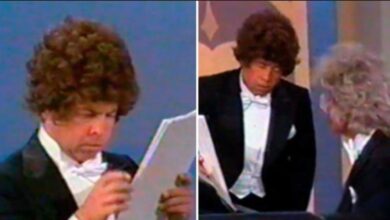Sniff ‘n’ the Tears’ “Driver’s Seat” Captures an Era of Restless Melancholy and Becomes an Enduring Cult Classic in 1978
Released in 1978, “Driver’s Seat” by Sniff ‘n’ the Tears carved out a unique place in rock history. With its atmospheric groove, steady pulse, and poetic ambiguity, the song offered a driving, introspective anthem at a time when disco reigned and punk was on the rise. It wasn’t a blockbuster chart-topper on initial release—peaking modestly in the UK and reaching No. 15 on the Billboard Hot 100 in the United States in 1979—but its staying power would surprise even its creators. Over the years, it would become one of the most recognizable “one-hit wonders” of the era, its brooding energy resonating with generations of listeners.
Sniff ‘n’ the Tears was the brainchild of British singer-songwriter Paul Roberts, a painter by profession and a lyricist with a keen ear for texture and mood. The band formed in London and coalesced around Roberts’ artistic vision. Rather than chasing trends, the group’s debut album Fickle Heart delivered an eclectic mix of rock, folk, and synth-infused grooves, with “Driver’s Seat” as its standout track. Roberts’ vocals—dry, contemplative, and slightly world-weary—were a stark contrast to the era’s flamboyance, giving the song its emotional weight.
The inspiration behind “Driver’s Seat” wasn’t about cars or road trips, despite what its title suggests. According to Roberts, it was a metaphor for control—or rather, the loss of it. Written in the aftermath of a breakup, the lyrics explore emotional dislocation, a desire for stability, and the bittersweet detachment that follows romantic upheaval. Phrases like “doing all right / a little jiving on a Saturday night” project a façade of cool, while underneath lies a restlessness that makes the song more than just a late-night radio staple—it’s a confession dressed in motion.
The song’s sonic identity is built on layers of subtle tension. Produced by Luigi Salvoni and engineered by Steve Lipson, “Driver’s Seat” opens with a crisp snare hit, soon joined by a hypnotic guitar riff and steady bassline. The interplay of piano, Mellotron, and electric guitar weaves a soundscape that feels both expansive and intimate. The use of studio space and dynamic shifts gives the song a sense of momentum—even as the lyrics describe a sense of being emotionally adrift.
When it was released, “Driver’s Seat” didn’t cause an immediate stir in the UK. In fact, it barely charted. But in the U.S., particularly through radio stations on the East and West Coasts, it found an eager audience. The song entered the Billboard Hot 100 in early 1979 and gradually climbed to No. 15—a surprising feat for a relatively unknown British band with little promotional push. Its subdued coolness stood out in a landscape filled with disco fever and punk angst. Critics praised its production and songwriting, though its commercial peak would remain relatively short-lived.
Despite not spawning any further major hits, the song left a significant mark on the cultural landscape. It became a favorite on FM radio, especially during nighttime programming blocks, where its moody tone fit perfectly. Over the years, its inclusion in film and TV soundtracks—most notably in the 1997 film Boogie Nights—helped cement its cult status. The track became a sonic shorthand for quiet intensity and late-1970s introspection.
For Sniff ‘n’ the Tears, the success of “Driver’s Seat” provided a brief moment of international recognition. But the band struggled with lineup changes and shifting musical currents. Despite releasing several more albums, they couldn’t replicate the magic—or the commercial reach—of their debut single. Paul Roberts would remain the constant force in the group, continuing to record and tour under the name for decades, supported by rotating bandmates and a loyal fanbase.
The song’s influence can be felt in later artists who embrace subtle emotional storytelling. Bands like The War on Drugs, Elbow, and even early R.E.M. have tapped into a similar sonic landscape—where lyrics float like diary entries over polished but unobtrusive instrumentation. “Driver’s Seat” didn’t birth a subgenre, but it did quietly inspire a mood: the emotionally detached narrator drifting through the neon haze of life.
It has been covered, sampled, and referenced multiple times, though rarely reinterpreted in its entirety. Its distinct feel—part soft rock, part art pop—makes it hard to reimagine. The original version remains definitive, its exact blend of melody and atmosphere hard to replicate. Yet its enduring presence on compilation albums and classic hits playlists keeps it alive, quietly whispering to new listeners in the digital age.
Interestingly, the song found renewed popularity in Europe decades after its release. In 1991, it hit No. 1 in the Netherlands when it was used in a Dutch advertising campaign, proving its strange longevity and ability to connect across time and culture. It’s a rare case of a song achieving delayed success—reinforcing the idea that sometimes, art just needs time to find the right ears.
More than 45 years since its release, “Driver’s Seat” continues to draw in new audiences. Whether through a nostalgic needle drop in a movie, a nighttime radio rotation, or a YouTube algorithm surprise, the song carries with it a kind of ageless melancholy. It doesn’t demand attention—it simply lingers, like a thought you can’t shake on a quiet drive.
It never became a cultural juggernaut, nor was it ever intended to be. But in its restraint, in its mood, and in its message, “Driver’s Seat” became timeless. It captures the feeling of looking at your reflection in a car window while the world moves past—of being in control, yet somehow lost. And that, perhaps more than any chart placement, is what makes it unforgettable.





